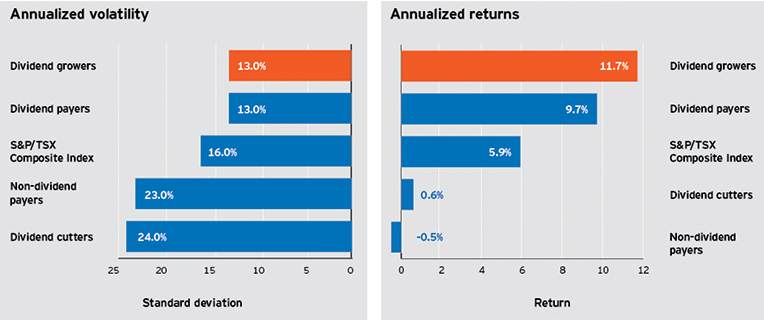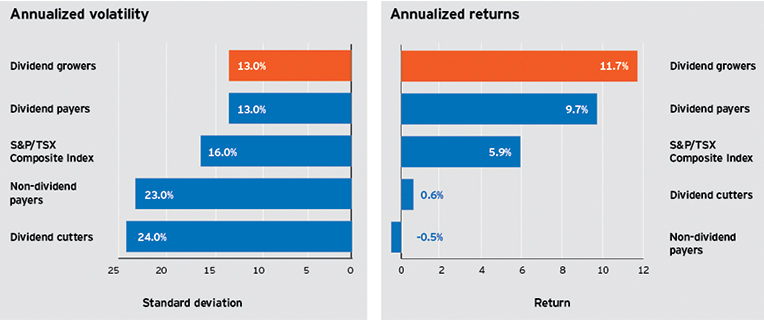The power of dividend growth
The case for dividend income has become even more compelling as record-low interest rates and macroeconomic conditions have driven bond yields down. In uncertain and choppy markets, yield-starved investors are looking for ways to satisfy their income needs.
But what about those seeking capital growth? Investing in companies that have a history of not only paying, but increasing, their dividends can provide both capital growth and income – as these companies have historically outperformed the broad market over time (see chart below). A high-conviction focus on dividend growth as an investment factor can result in higher yield than the broader market and overall growth potential from stock price increases.
Steady growth vs. current yield
A dividend grower is a company that not only pays a dividend, but has consistently increased its dividend over time. Why does this matter to an investor? While it may seem enough to simply focus on the current dividend yield relative to income needs, this only tells part of the story.
Companies that consistently grow their dividends tend to be those that are mature enough in the business lifecycle to be able to pay dividends and yet still have room for continued business growth through reinvestment projects. Dividends are certainly an important part of overall returns, but dividend growth over time demonstrates a level of stability and growth potential that a high dividend alone doesn’t.
A high, above-market dividend payment may signal that a company is undervalued. The high yield simply may not be sustainable during down markets, which could lead to a dividend cut and subsequent drop in share price during tough times. It can also indicate a lack of long-term thinking if excess cash flow isn’t required for plans to grow the business. High-conviction investing based on dividend growth as a factor can help mitigate these issues by focusing on steady growth over current yield.
A steadily growing dividend can be an indicator of a company’s overall corporate health. Businesses that have consistently grown their dividend over time tend to illustrate key merits of financial strength. Put another way, the consistent increase may be a by-product of corporate health, intelligent capital allocation decisions and consistent earnings growth. The fact that they consistently have free cash flow available to increase the dividend after they’ve taken care of future growth by investing in the business is a key determinant of both stability and quality. These businesses are generally more likely to exhibit resiliency in tough economic environments.
Historically, dividend growers have traded at a higher price-to-earnings ratio (P/E) than companies that pay higher dividends because they tend to grow faster. However, there has been a shift in this norm, as many investors seeking yield are making buying decisions based solely on current yield, pushing valuations for high-dividend paying companies beyond those of the dividend growers. Investors can take advantage of this price gap by focusing on dividend growers over simply current yield.
Dividend growers over time
The chart below shows how dividend growers have fared over the long term, both in terms of volatility and performance. Dividend growers have not only outperformed, but have also provided a much smoother ride for investors along the way – demonstrating that investors don’t need to choose between income and growth. Why not strive for both?

Source: RBC Capital Markets Quantitative Research. Data is calculated on an equal-weight basis using the S&P/TSX Composite Total Return Index between October 1986 and July 2015. Dividend cutters represent stocks that have lowered or eliminated their dividend; non-dividend payers represent non-dividend-paying stocks; dividend payers with no changes represent all dividend-paying stocks that have maintained their existing dividend rate; and dividend growers represent all dividend-paying stocks that raised their existing dividend.
Finding dividend growers
High-conviction, active portfolio managers use a disciplined approach to researching companies, looking past markets trends to find high-quality dividend growers at the right price.
Factor-based smart beta strategies can provide exposure to dividend growers by following an index focused on companies that exhibit a history of increasing dividend payments, such as the Nasdaq Select Canadian Dividend Index.
The following actively managed and factor-based, smart beta strategies recognize the importance of dividend growers:
If you have any questions about dividend growers or how access to these companies can impact your portfolio, please leave a comment below.
This post was originally published at Invesco Canada Blog
Copyright © Invesco Canada Blog














